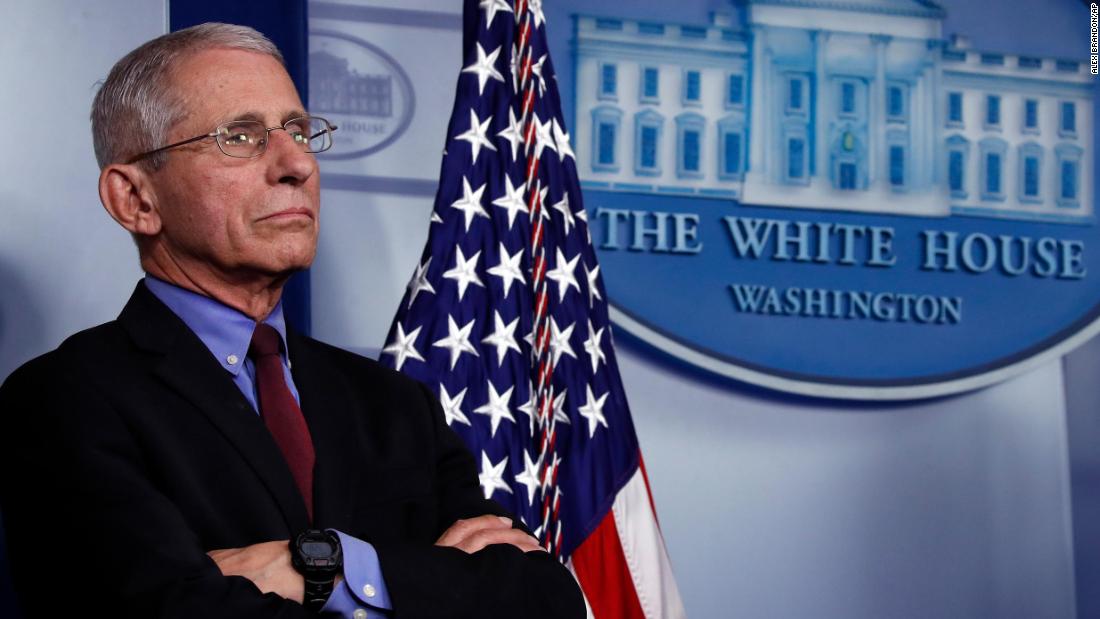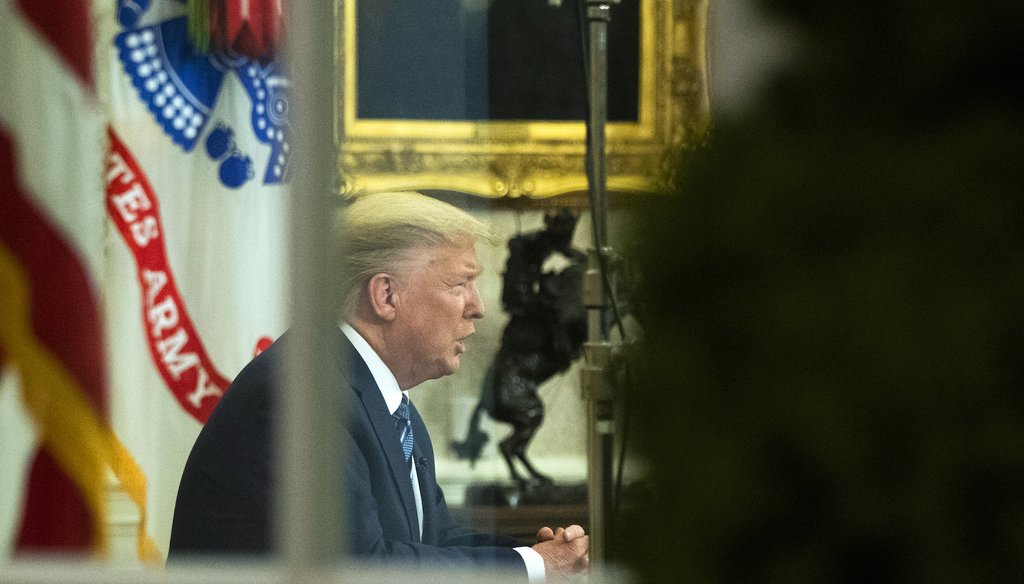Editor's note: We updated the timeline Jan. 19, 2021. In the span of one year, Americans went from hearing about a new v

www.politifact.com
Timeline: How Donald Trump responded to the coronavirus pandemic
By
Jon GreenbergMarch 20, 2020
IF YOUR TIME IS SHORT
- After the disease was in Washington state and the World Health Organization reported a high global risk, Trump said there were no worries of a pandemic.
- The day the stock market plummeted, Trump said the virus was very much under control in the U.S., and the stock market was looking pretty good to him.
- A few days after declaring a national emergency, Trump said he had “always known” this was a pandemic. (That’s Pants on Fire.)
In the span of three months, Americans went from hearing about a new virus in central China to being told they ought to stay home and avoid groups larger than 10. President Donald Trump went from telling people not to worry and everything was under control to leading daily press conferences on containing the outbreak in the United States.
The rapidly evolving story can be broken down into three phases: the emergence of the threat, the government’s focus on keeping it out of the United States, and finally, its efforts to contain the spread.
Here are the key moments in each phase, and what Trump said at those times — fact-checked.
Phase One: The disease emerges
Dec. 31: China
confirms existence of a new virus.
Jan. 20: World Health Organization
reports cases in China, Thailand, Japan, and South Korea.
Jan. 21: The first U.S. case
is announced in Washington state (as well as Vietnam and Singapore). WHO says the
virus risk globally is high.
Jan. 22: A reporter asks if there are
worries about a pandemic. Trump responds:
"No. Not at all. And we have it totally under control. It’s one person coming in from China, and we have it under control. It’s — going to be just fine."
Jan. 24: Trump
tweets, "It will all work out well."

Donald J. Trump
 @realDonaldTrump
https://twitter.com/realDonaldTrump/status/1220818115354923009
@realDonaldTrump
https://twitter.com/realDonaldTrump/status/1220818115354923009
China has been working very hard to contain the Coronavirus. The United States greatly appreciates their efforts and transparency. It will all work out well. In particular, on behalf of the American People, I want to thank President Xi!
125K
4:18 PM - Jan 24, 2020
Twitter Ads info and privacy
35.2K people are talking about this
Jan 29: The White House forms a
coronavirus response task force, initially led by Health and Human Services Secretary Alex Azar.
Jan. 30: The WHO declares a
global health emergency.
Phase Two: Keeping it out of the United States
Jan. 30: Trump
blocks travel from China.
The same night, he holds a
campaign rally in Iowa.
"We think we have it very well under control. We have very little problem in this country at this moment — five. ... we think it’s going to have a very good ending for it."
Feb. 2: Trump tells
Fox News host Sean Hannity, "We pretty much shut it down coming in from China."
Feb. 4: Diamond Princess cruise ship quarantined in Yokohama, Japan. Over 2,600 guests and over 1,000 crew. Within two days, over 40 people test positive for COVID-19, including eight Americans.
Feb. 11: WHO
names the new disease COVID-19.
Feb 14: Trump
discusses the "very small" number of U.S. coronavirus cases with Border Patrol Council members:
"We have a very small number of people in the country, right now, with it. It’s like around 12. Many of them are getting better. Some are fully recovered already. So we’re in very good shape."
Feb. 20: WHO reports nearly
77,000 cases worldwide in 27 countries.
Feb. 24: Stock market plummets as
Dow Jones Industrials falls more than 1,000 points.
The same day, Trump asks for
$1.25 billion in emergency aid. It grows to $8.3 billion in Congress.He
tweets that the virus "is very much under control" and the stock market "starting to look very good to me!"

Donald J. Trump
 @realDonaldTrump
https://twitter.com/realDonaldTrump/status/1232058127740174339
@realDonaldTrump
https://twitter.com/realDonaldTrump/status/1232058127740174339
The Coronavirus is very much under control in the USA. We are in contact with everyone and all relevant countries. CDC & World Health have been working hard and very smart. Stock Market starting to look very good to me!
143K
4:42 PM - Feb 24, 2020
Twitter Ads info and privacy
65.7K people are talking about this
Feb. 26: The first case emerges in
California with no clear source, suggesting community spread of the virus.
In a
news conference that day, Trump says the United States is "really prepared." He puts Vice President Mike Pence in charge of the White House task force.
Feb. 28: Cases rise
across Europe, including Italy, Germany, France, England, Switzerland and Belarus.
Phase Three: Containing the spread
Feb. 29: FDA eases guidelines to speed the broader use of testing.
March 4: House passes
$8.3 billion emergency bill, aimed mainly at the immediate health response to the virus.
In a Fox News interview, Trump deflects criticism to his response by saying the Obama administration (including the vice president, Joe Biden) "didn't do anything about" swine flu. We rated the claim
False.
Trump continues to blame the Obama administration in an exchange with reporters at the White House.
"The Obama administration made a decision on testing that turned out to be very detrimental to what we’re doing."
Our fact-check shows the process dated back to 2006, before Obama took office. So the claim is
False.
March 6: Grand Princess cruise ship with over 2,000 passengers waits to dock off the California coast.
Asked about the docking of the Grand Princess, Trump says the following:
"I would rather (Grand Princess passengers stay aboard) because I like the numbers being where they are. I don’t need to have the numbers double because of one ship."
Trump went on to say that he thought it was more important for passengers to debark than to keep the numbers down.
In a
news conference, Trump downplays the concerns around testing:
"Anybody that wants a test can get a test."
With tests in short supply, we rated the claim
Pants on Fire.
The same day, Trump
tweets out blame to the media and the Democrats for trying to "inflame" the situation "far beyond what the facts would warrant."

Donald J. Trump
 @realDonaldTrump
https://twitter.com/realDonaldTrump/status/1236975196642390022
@realDonaldTrump
https://twitter.com/realDonaldTrump/status/1236975196642390022
The Fake News Media and their partner, the Democrat Party, is doing everything within its semi-considerable power (it used to be greater!) to inflame the CoronaVirus situation, far beyond what the facts would warrant. Surgeon General, “The risk is low to the average American.”
90.8K
6:20 AM - Mar 9, 2020
Twitter Ads info and privacy
41.2K people are talking about this
March 11: On the same day the WHO
declares COVID-19 a pandemic, Trump uses a prime-time
Oval Office address to announce a ban on travel for non-Americans from most of Europe. He misstates a
freeze on cargo and
falsely said the health insurance industry has "agreed to waive all co-payments for coronavirus treatments." In reality, getting tested would be free, but treatment would not be covered.
March 13: Trump
declares a national emergency to access $50 billion for states and territories, and clear the way for fast-track waivers for hospitals and doctors as they respond to the virus.
March 14: The House passes a worker and business
relief bill with paid leave guarantees for certain workers, expanded food assistance and unemployment insurance benefits, and employer tax credits. Trump signs it four days later.
March 17: Trump said in a
news conference that for the next 14 days, "we’re asking everyone to work at home, if possible, postpone unnecessary travel, and limit social gatherings to no more than 10 people."
Trump says there was no shift in tone from the White House.
"I've always known this is a real, this is a pandemic. I've felt it was a pandemic long before it was called a pandemic."
As this timeline shows, Trump minimized the threat of a pandemic for many weeks.
Pants on Fire!
Asked if the World Health Organization had offered detection tests to the United States, Trump said WHO had not, and that the WHO coronavirus test "was a bad test."
False. WHO said three independent labs had validated the test, and the White House coordinator for coronavirus response said she assumed the WHO test is effective.
March 19: The U.S. Senate unveils a
$1 trillion-plus economic stimulus package. California orders lockdown for 40 million residents.
March 20-23: New York Gov. Andrew Cuomo orders all non-essential businesses to keep their workers home. Indiana, Louisiana, Ohio, Illinois and
many other states issue similar restrictions.
March 24: Having
tweeted on the economic shutdown that "we cannot let the cure be worse than the problem itself," Trump says in a
Fox News town hall he would "love to have the country opened up, and just raring to go by Easter."
Trump responds to a request from Cuomo for ventilators, reading from papers in his hand:
"(He) rejected buying recommended 16,000 ventilators in 2015 for the pandemic, for a pandemic, established death panels and lotteries instead. So, he had a chance to buy, in 2015, 16,000 ventilators at a very low price, and he turned it down."
False. A state study said that many might be needed in a crisis, but it also said there were immediate pressing health needs, and there was no money to buy that many ventilators.
That evening, Dr. Anthony Fauci, head of the National Institute of Allergy and Infectious Diseases, tells
Fox News that Trump is flexible on economic restrictions: "The president clearly listens. I mean, he has this aspirational goal of hoping that we might be able to do it by a certain date. We talked with him about that. We say we need to be flexible. He realizes that and he accepts that."
March 27: Trump signs
$2.2 trillion emergency spending bill. The act provides $1,200 per individual and $500 per child for households making up to $150,000 a year. Small businesses are eligible for loans — that can be forgiven — from a $377 billion fund. There’s a $454 billion fund for companies and state and local governments, and $180 billion for the health care sector. The details for families and small businesses
are here. Details for corporations, states and health care,
here.
Phase Four: Shifting expectations
March 29: Trump reverses course on relaxing strict stay-at-home guidance by Easter and
extends the period to the end of April.
"The peak, the highest point of death rates — remember this — is likely to hit in two weeks," he said. "Nothing would be worse than declaring victory before the victory is won. That would be the greatest loss of all."
In the press conference, he argues with "PBS NewsHour" reporter Yamiche Alcindor over what the president had said, or hadn’t said, about New York’s need for ventilators.
Trump falsely denied saying that governors were requesting equipment they didn’t need.
March 30: Cases top
163,000. The number of tests
crosses the 1 million mark, still behind where the country needs to be. Trump tells Fox News:
"We inherited a broken test" for COVID-19.
Trump’s impossible claim is
Pants on Fire. There could be no test before the new virus emerged. China first confirmed its existence Dec. 31, 2019, and shared its genetic sequence Jan. 7. The CDC’s first shipment of tests to states contained tainted reagents. That and bureaucratic delays cost the U.S. several critical weeks in testing.
March 31: Trump asks Americans to be prepared for the "
hard days that lie ahead."
"This is going to be a very painful — very, very painful two weeks," he said. "When you look and see at night the kind of death that's been caused by this invisible enemy, it's — it's incredible."
The coronavirus death toll reaches about
3,700.




 @realDonaldTrump
@realDonaldTrump